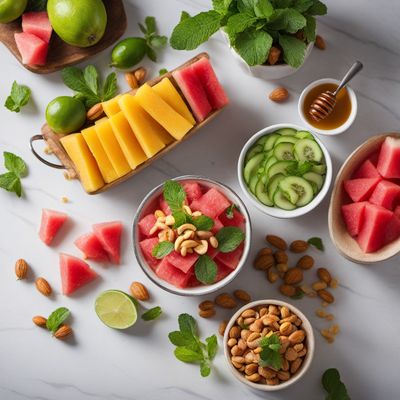
Ingredient
Papayas
The Tropical Delight: Papayas
Papayas have a soft and buttery texture with a subtly sweet and musky flavor. The flesh is usually orange or pink, while the skin can range from green to yellow. The fruit is filled with small black seeds that are edible but have a slightly bitter taste. Papayas are often described as a cross between a melon and a mango.
Origins and history
Papayas are native to Central and South America and have been cultivated for thousands of years. They were highly valued by the Mayans and Aztecs for their medicinal properties and were considered a symbol of fertility and abundance. Today, papayas are grown in tropical regions around the world and are enjoyed for their refreshing taste and numerous health benefits.
Nutritional information
Papayas are a rich source of vitamin C, vitamin A, and dietary fiber. They also contain enzymes like papain, which aids in digestion. Additionally, papayas provide small amounts of potassium, magnesium, and folate. They are low in calories and fat, making them a healthy choice for a sweet treat.
Allergens
May cause allergic reactions in individuals with latex allergies.
How to select
When selecting papayas, choose fruits that are slightly soft to the touch and have a pleasant aroma. Avoid papayas that are overly soft or have blemishes or mold. The skin should be free from wrinkles or deep indentations. Opt for organic or locally grown papayas whenever possible to support sustainable farming practices.
Storage recommendations
Ripe papayas should be stored in the refrigerator to slow down the ripening process and extend their shelf life. Unripe papayas can be left at room temperature until they reach the desired ripeness. Once cut, store papaya in an airtight container in the refrigerator and consume it within a few days.
How to produce
Papaya trees can be grown in tropical and subtropical regions. They require a warm climate with temperatures above 60°F (15°C) and well-drained soil. Papaya trees can be grown from seeds or propagated through cuttings. However, they require proper care and maintenance to ensure optimal growth and fruit production.
Preparation tips
Papayas can be enjoyed fresh on their own or added to fruit salads, smoothies, or desserts. They can also be used in savory dishes like salsas or salads to add a touch of sweetness. The seeds can be dried and ground into a powder, which can be used as a natural meat tenderizer or added to dressings and marinades.
Substitutions
Mango, cantaloupe
Culinary uses
Papayas are widely used in tropical cuisines, particularly in Latin American, Caribbean, and Southeast Asian dishes. They are commonly used in fruit salads, juices, and desserts like papaya boats or papaya pudding. In savory dishes, they are often paired with ingredients like lime, chili, or seafood to create a refreshing and tangy flavor combination.
Availability
Mexico, Brazil, India, Thailand
More ingredients from this category
Recipes using Papayas » Browse all

Green PawPaw Curry
Tropical Delight Curry: Green PawPaw Extravaganza

Refreshing Vietnamese Fruit Salad
Tropical Delight: Vietnamese Fruit Salad with a Twist

Mexican-American Haft Mewa Salad
Fiesta Fruit Salad: A Mexican-American Twist on Haft Mewa

Papaya Delight Chutney
Tropical Twist: Papaya Delight Chutney

Creamy Papaya Delight
Tropical Bliss: Creamy Papaya Delight

Papaya Delight with a Twist
Portuguese Papaya Surprise

Luwombo Niuean-Style
Tropical Delight Luwombo: A Taste of Niuean Paradise

Antiguan and Barbudan Rujak Cuka
Tropical Fruit Salad with Tangy Dressing

Bermudian Reinforced Salad
Tropical Twist: Bermudian Reinforced Salad with a Caribbean Flair

Zambian Fruit Salad
Tropical Delight: Zambian Fruit Salad with a Twist

Rujak - Indonesian Spicy Fruit Salad
Fiery Fusion: A Burst of Flavors in Indonesian Spicy Fruit Salad

Marshallese Island Salad
Tropical Delight: Marshallese Island Salad
